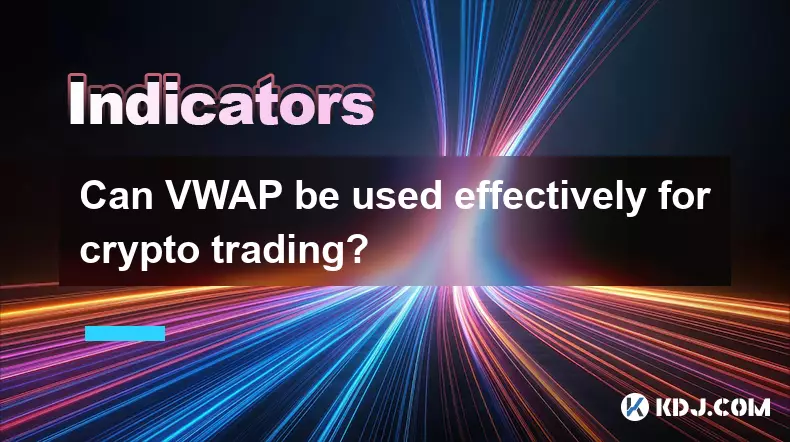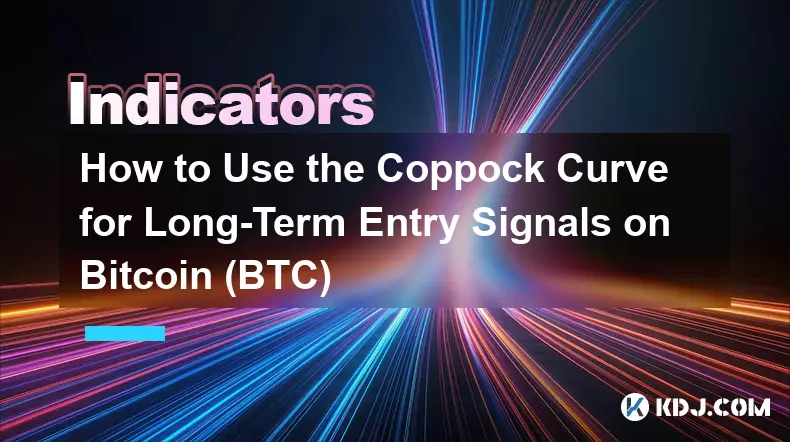-
 bitcoin
bitcoin $107015.826941 USD
-2.18% -
 ethereum
ethereum $3637.352324 USD
-5.18% -
 tether
tether $0.999831 USD
-0.02% -
 xrp
xrp $2.338078 USD
-6.23% -
 bnb
bnb $998.272150 USD
-6.97% -
 solana
solana $167.598257 USD
-10.12% -
 usd-coin
usd-coin $0.999863 USD
0.01% -
 tron
tron $0.282573 USD
-5.09% -
 dogecoin
dogecoin $0.169891 USD
-7.39% -
 cardano
cardano $0.557554 USD
-7.03% -
 hyperliquid
hyperliquid $39.914802 USD
-5.85% -
 chainlink
chainlink $15.414549 USD
-9.97% -
 bitcoin-cash
bitcoin-cash $510.361911 USD
-4.26% -
 ethena-usde
ethena-usde $0.999194 USD
-0.03% -
 stellar
stellar $0.282092 USD
-6.07%
Can VWAP be used effectively for crypto trading?
VWAP helps crypto traders gauge fair price by weighting volume, improving execution accuracy and identifying momentum in volatile markets.
Oct 17, 2025 at 08:55 pm

Understanding VWAP in the Context of Cryptocurrency Markets
1. The Volume Weighted Average Price (VWAP) is a trading benchmark that calculates the average price of an asset based on both volume and price over a specified time period. Originally developed for traditional financial markets, it has found increasing application in crypto trading due to its ability to reflect true market sentiment.
2. In highly volatile cryptocurrency markets, where price swings can be abrupt and driven by speculative activity, VWAP helps traders identify whether the current price is favorable compared to the average transaction cost throughout the day. This makes it particularly useful for assessing momentum and spotting potential entry or exit points.
3. Unlike simple moving averages, VWAP incorporates trading volume into its calculation, giving more weight to periods with higher activity. This provides a clearer picture of where institutional and high-volume participants are executing trades, which is crucial in markets where large whales can significantly influence price movements.
4. Crypto exchanges often lack the regulatory oversight and transparency of traditional stock markets, leading to fragmented liquidity across platforms. VWAP helps consolidate this information within a single exchange’s data feed, offering a reliable reference point for evaluating trade execution quality.
5. Traders using algorithmic strategies frequently integrate VWAP as a core component because it supports decision-making based on real-time supply and demand dynamics. Its responsiveness to surges in volume allows automated systems to adjust positioning dynamically during breakout or reversal scenarios.
VWAP Enhances Trade Execution Accuracy
1. When entering large positions in cryptocurrencies like Bitcoin or Ethereum, minimizing slippage is critical. Using VWAP as a benchmark enables traders to assess whether their execution price is better or worse than the average market price adjusted for volume. This is especially important during periods of low liquidity when market orders can cause significant price impact.
2. Market participants aiming to replicate index-like behavior or execute large buy/sell programs use VWAP to spread their orders throughout the trading session. By aligning trades with volume patterns, they reduce the risk of distorting prices and drawing unwanted attention from other traders.
3. Day traders monitor deviations from VWAP to detect short-term imbalances between buyers and sellers. A price consistently above VWAP suggests strong buying pressure, while sustained trading below indicates dominance by sellers—insights that inform intraday directional bets.
4. Some advanced trading bots are programmed to target VWAP crossovers as signals. For example, a close above VWAP after a pullback may trigger long entries, assuming the move is supported by rising volume. These rule-based approaches benefit from the objectivity VWAP introduces into decision-making.
5. In fast-moving crypto markets, sudden news events or macroeconomic announcements can cause sharp dislocations from fair value. VWAP acts as a stabilizing metric, helping traders distinguish between transient noise and genuine shifts in market structure.
Limitations and Practical Considerations
1. VWAP is inherently lagging since it relies on historical data within the chosen timeframe, typically starting at market open. In 24/7 crypto markets without a defined opening bell, determining the start point becomes subjective and can vary between traders.
2. On smaller or less liquid altcoin pairs, erratic volume patterns can distort VWAP readings. Thin order books mean that even modest trades can skew the average, reducing its reliability as a representative price level.
3. While effective on major exchanges like Binance or Coinbase, VWAP values differ across platforms due to divergent volume profiles. A trader relying solely on one exchange’s VWAP may miss broader market context, especially during arbitrage opportunities or cross-exchange manipulations.
4. VWAP works best when combined with complementary tools such as order book depth analysis, time-of-day volume trends, or volatility indicators. Relying exclusively on VWAP risks oversimplifying complex market conditions unique to digital assets.
5. Because VWAP resets daily, longer-term investors find limited utility in it. Positional traders focusing on weekly or monthly horizons often prefer volume-adjusted moving averages or on-chain metrics instead.
Frequently Asked Questions
How is VWAP calculated in crypto trading?VWAP is computed by summing the product of typical price (high + low + close / 3) and volume for each period, then dividing by total volume over the same interval. Most charting platforms automate this process across user-defined timeframes.
Can VWAP be used on all cryptocurrency pairs?It is most effective on high-volume pairs like BTC/USDT or ETH/BUSD. Low-cap coins with inconsistent trading activity produce unreliable VWAP lines due to sparse and irregular volume inputs.
Is VWAP suitable for swing trading?While primarily designed for intraday use, some swing traders apply modified versions such as cumulative VWAP over multiple days. However, standard daily VWAP loses relevance beyond 24-hour cycles.
Do professional crypto traders use VWAP?Yes, many institutional-grade trading desks and algo funds incorporate VWAP into execution algorithms to minimize market impact and improve fill rates, especially when deploying large capital amounts.
Disclaimer:info@kdj.com
The information provided is not trading advice. kdj.com does not assume any responsibility for any investments made based on the information provided in this article. Cryptocurrencies are highly volatile and it is highly recommended that you invest with caution after thorough research!
If you believe that the content used on this website infringes your copyright, please contact us immediately (info@kdj.com) and we will delete it promptly.
- XRP, BlockDAG, and Presales: Decoding the Hottest Crypto Trends
- 2025-11-04 22:50:12
- $PLAI Token Set to Launch on KuCoin: Mainnet Goes Live!
- 2025-11-04 23:10:02
- Moonwell's Oracle Exploit: A Wake-Up Call for DeFi Price Feeds
- 2025-11-04 23:05:01
- Chainlink (LINK) Crypto Explosion: Will It Hold or Fold?
- 2025-11-04 23:10:14
- Nature's Miracle, Super Point, and Stablecoin: A New Era for Loyalty Rewards?
- 2025-11-04 22:40:02
- ADA Slowdown, Maxi Doge, and the Meme Coin Mania: What's the Hype?
- 2025-11-04 20:50:12
Related knowledge

Technical analysis for crypto: using RSI and MACD to find trading signals.
Nov 03,2025 at 03:18pm
Decentralized Exchanges Are Reshaping Trading Dynamics1. Decentralized exchanges (DEXs) have gained significant traction by eliminating intermediaries...

The Best Exponential Moving Average (EMA) Settings for Crypto Swing Trading
Oct 25,2025 at 04:55pm
The Best Exponential Moving Average (EMA) Settings for Crypto Swing TradingSwing trading in the cryptocurrency market relies heavily on identifying tr...

How to Use the Coppock Curve for Long-Term Entry Signals on Bitcoin (BTC)
Oct 31,2025 at 03:01pm
Understanding the Coppock Curve in Bitcoin Analysis1. The Coppock Curve is a momentum indicator originally designed for stock market indices but has f...

A Beginner's Guide to Finding Divergence with the MACD on the Solana (SOL) Chart
Oct 26,2025 at 12:36pm
Understanding MACD and Its Role in Solana Trading1. The Moving Average Convergence Divergence (MACD) is a momentum indicator widely used in cryptocurr...

How to Use the Aroon Indicator to Identify New Trends in Cardano (ADA)
Oct 26,2025 at 10:18pm
Understanding the Aroon Indicator in Cryptocurrency Trading1. The Aroon indicator is a technical analysis tool designed to identify whether an asset i...

Trading the Ichimoku Cloud "Kumo Twist" for Ethereum (ETH) Reversals
Oct 27,2025 at 01:54am
Understanding the Ichimoku Cloud and Its Components1. The Ichimoku Cloud, also known as Ichimoku Kinko Hyo, is a comprehensive technical analysis tool...

Technical analysis for crypto: using RSI and MACD to find trading signals.
Nov 03,2025 at 03:18pm
Decentralized Exchanges Are Reshaping Trading Dynamics1. Decentralized exchanges (DEXs) have gained significant traction by eliminating intermediaries...

The Best Exponential Moving Average (EMA) Settings for Crypto Swing Trading
Oct 25,2025 at 04:55pm
The Best Exponential Moving Average (EMA) Settings for Crypto Swing TradingSwing trading in the cryptocurrency market relies heavily on identifying tr...

How to Use the Coppock Curve for Long-Term Entry Signals on Bitcoin (BTC)
Oct 31,2025 at 03:01pm
Understanding the Coppock Curve in Bitcoin Analysis1. The Coppock Curve is a momentum indicator originally designed for stock market indices but has f...

A Beginner's Guide to Finding Divergence with the MACD on the Solana (SOL) Chart
Oct 26,2025 at 12:36pm
Understanding MACD and Its Role in Solana Trading1. The Moving Average Convergence Divergence (MACD) is a momentum indicator widely used in cryptocurr...

How to Use the Aroon Indicator to Identify New Trends in Cardano (ADA)
Oct 26,2025 at 10:18pm
Understanding the Aroon Indicator in Cryptocurrency Trading1. The Aroon indicator is a technical analysis tool designed to identify whether an asset i...

Trading the Ichimoku Cloud "Kumo Twist" for Ethereum (ETH) Reversals
Oct 27,2025 at 01:54am
Understanding the Ichimoku Cloud and Its Components1. The Ichimoku Cloud, also known as Ichimoku Kinko Hyo, is a comprehensive technical analysis tool...
See all articles










































































